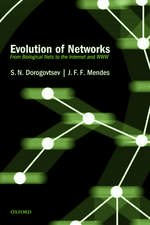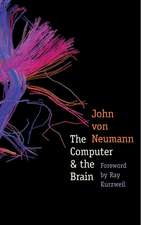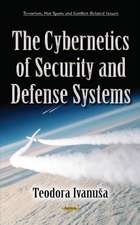A First Course in Information Theory: Information Technology: Transmission, Processing and Storage
Autor Raymond W. Yeungen Limba Engleză Hardback – 30 apr 2002
Toate formatele și edițiile
| Toate formatele și edițiile | Preț | Express |
|---|---|---|
| Paperback (1) | 1114.65 lei 6-8 săpt. | |
| Springer Us – 30 oct 2012 | 1114.65 lei 6-8 săpt. | |
| Hardback (1) | 1119.08 lei 6-8 săpt. | |
| Springer Us – 30 apr 2002 | 1119.08 lei 6-8 săpt. |
Din seria Information Technology: Transmission, Processing and Storage
- 15%
 Preț: 633.53 lei
Preț: 633.53 lei - 15%
 Preț: 636.80 lei
Preț: 636.80 lei - 15%
 Preț: 528.63 lei
Preț: 528.63 lei -
 Preț: 389.49 lei
Preț: 389.49 lei - 20%
 Preț: 343.12 lei
Preț: 343.12 lei - 15%
 Preț: 587.72 lei
Preț: 587.72 lei - 18%
 Preț: 1398.00 lei
Preț: 1398.00 lei - 15%
 Preț: 650.55 lei
Preț: 650.55 lei - 15%
 Preț: 655.78 lei
Preț: 655.78 lei - 15%
 Preț: 649.06 lei
Preț: 649.06 lei -
 Preț: 416.05 lei
Preț: 416.05 lei - 20%
 Preț: 610.31 lei
Preț: 610.31 lei - 18%
 Preț: 955.70 lei
Preț: 955.70 lei - 18%
 Preț: 960.78 lei
Preț: 960.78 lei - 15%
 Preț: 640.88 lei
Preț: 640.88 lei - 18%
 Preț: 954.31 lei
Preț: 954.31 lei - 20%
 Preț: 346.24 lei
Preț: 346.24 lei - 20%
 Preț: 649.09 lei
Preț: 649.09 lei - 18%
 Preț: 1687.01 lei
Preț: 1687.01 lei - 18%
 Preț: 1686.04 lei
Preț: 1686.04 lei - 18%
 Preț: 1856.54 lei
Preț: 1856.54 lei - 20%
 Preț: 352.54 lei
Preț: 352.54 lei
Preț: 1119.08 lei
Preț vechi: 1364.73 lei
-18% Nou
Puncte Express: 1679
Preț estimativ în valută:
214.13€ • 223.57$ • 177.22£
214.13€ • 223.57$ • 177.22£
Carte tipărită la comandă
Livrare economică 05-19 aprilie
Preluare comenzi: 021 569.72.76
Specificații
ISBN-13: 9780306467912
ISBN-10: 0306467917
Pagini: 412
Ilustrații: XXIII, 412 p.
Dimensiuni: 155 x 235 x 26 mm
Greutate: 0.74 kg
Ediția:2002
Editura: Springer Us
Colecția Springer
Seria Information Technology: Transmission, Processing and Storage
Locul publicării:New York, NY, United States
ISBN-10: 0306467917
Pagini: 412
Ilustrații: XXIII, 412 p.
Dimensiuni: 155 x 235 x 26 mm
Greutate: 0.74 kg
Ediția:2002
Editura: Springer Us
Colecția Springer
Seria Information Technology: Transmission, Processing and Storage
Locul publicării:New York, NY, United States
Public țintă
ResearchCuprins
1. The Science of Information.- Information Measures.- 2.1 Independence and Markov Chains.- 2.2 Shannon’s Information Measures.- 2.3 Continuity of Shannon’s Information Measures.- 2.4 Chain Rules.- 2.5 Informational Divergence.- 2.6 The Basic Inequalities.- 2.7 Some Useful Information Inequalities.- 2.8 Fano’s Inequality.- 2.9 Entropy Rate of Stationary Source.- Problems.- Historical Notes.- 3. Zero-Error Data Compression.- 3.1 The Entropy Bound.- 3.2 Prefix Codes.- 3.3 Redundancy of Prefix Codes.- Problems.- Historical Notes.- 4. Weak Typicality.- 4.1 The Weak.- 4.2 The Source Coding Theorem.- 4.3 Efficient Source Coding.- 4.4 The Shannon-McMillan-Breiman Theorem.- Problems.- Historical Notes.- 5. Strong Typicality.- 5.1 Strong.- 5.2 Strong Typicality Versus Weak Typicality.- 5.3 Joint Typicality.- 5.4 An Interpretation of the Basic Inequalities.- Problems.- Historical Notes.- The I-measure.- 6.1 Preliminaries.- 6.2 The I-Measure for Two Random Variables.- 6.3 Construction of the I-Measure ?*.- 6.4 ?* Can be Negative.- 6.5 Information Diagrams.- 6.6 Examples of Applications.- Appendix 6.A: A Variation of the Inclusion-Exclusion Formula.- Problems.- Historical Notes.- 7. Markov Structures.- 7.1 Conditional Mutual Independence.- 7.2 Full Conditional Mutual Independence.- 7.3 Markov Random Field.- 7.4 Markov Chain.- Problems.- Historical Notes.- 8. Channel Capacity.- 8.1 Discrete Memoryless Channels.- 8.2 The Channel Coding Theorem.- 8.3 The Converse.- 8.4 Achievability of the Channel Capacity.- 8.5 A Discussion.- 8.6 Feedback Capacity.- 8.7 Separation of Source and Channel Coding.- Problems.- Historical Notes.- 9. Rate-Distortion Theory.- 9.1 Single-Letter Distortion Measures.- 9.2 The Rate-Distortion Function R(D).- 9.3 The Rate-Distortion Theorem.- 9.4 The Converse.- 9.5 Achievability of RI(D).- Problems.- Historical Notes.- The Blahut-Arimoto Algorithms.- 10.1 Alternating Optimization.- 10.2 The Algorithms.- 10.3 Convergence.- Problems.- Historical Notes.- 11. Single-Source Network Coding.- 11.1 A Point-to-Point Network.- 11.2 What is Network Coding?.- 11.3 A Network Code.- 11.4 The Max-Flow Bound.- 11.5 Achievability of the Max-Flow Bound.- Problems.- Historical Notes.- 12. Information Inequalities.- 12.1 The Region ?*n.- 12.2 Information Expressions in Canonical Form.- 12.3 A Geometrical Framework.- 12.4 Equivalence of Constrained Inequalities.- 12.5 The Implication Problem of Conditional Independence.- Problems.- Historical Notes.- 13. Shannon-Type Inequalities.- 13.1 The Elemental Inequalities.- 13.2 A Linear Programming Approach.- 13.3 A Duality.- 13.4 Machine Proving.- 13.5 Tackling the Implication Problem.- 13.6 Minimality of the Elemental Inequalities.- Appendix 13.A: The Basic Inequalities and the Polymatroidal Axioms.- Problems.- Historical Notes.- Problems.- Historical Notes.- 14. Beyond Shannon-Type Inequalities.- 14.1 Characterizations of ?*2,?*3, and ?*n.- 14.2 A Non-Shannon-Type Unconstrained Inequality.- 14.3 A Non-Shannon-TypeConstrained Inequality.- 14.4 Applications.- Problems.- Historical Notes.- 978-1-4419-8608-5_15.- 15.1 Two Characteristics.- 15.2 Examples of Application.- 15.3 A Network Code for Acyclic Networks.- 15.4 An Inner Bound.- 15.5 An Outer Bound.- 15.6 The LP Bound and Its Tightness.- 15.7 Achievability of Rin.- Appendix 15.A: Approximation of Random Variables with Infinite Alphabets.- Problems.- Historical Notes.- 16. Entropy and Groups.- 16.1 Group Preliminaries.- 16.2 Group-Characterizable Entropy Functions.- 16.3 A Group Characterization of ?*n.- 16.4 Information Inequalities and Group Inequalities.- Problems.- Historical Notes.
Caracteristici
Includes supplementary material: sn.pub/extras











